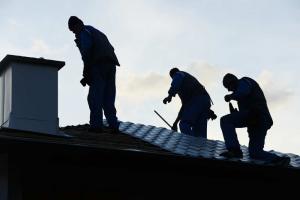Preventive Maintenance Pays Off: Annual Roof Inspection Checklist for Commercial Properties
An annual inspection isn’t just about looking for damage—it’s about extending the life of the roof and ensuring the rest of the building doesn’t suffer due to preventable failures”
WISCONSIN RAPIDS, WI, UNITED STATES, July 24, 2025 /EINPresswire.com/ -- Commercial property owners and facility managers are being encouraged to take a proactive approach to roof maintenance as seasonal changes and extreme weather continue to impact building integrity across Wisconsin. Regular roof inspections, especially annual evaluations, are now recognized as a critical part of a building’s preventive maintenance strategy.— Thad Brown
Thad Brown, owner and founder of Dynamic Alliance Roofing LLC in Wisconsin Rapids, Wisconsin, recommends that every commercial property manager follow a structured inspection checklist at least once a year to catch small issues before they become costly problems. With over four decades in the commercial roofing industry, Brown emphasizes the importance of early detection and consistency.
“An annual inspection isn’t just about looking for damage—it’s about extending the life of the roof and ensuring the rest of the building doesn’t suffer due to preventable failures,” said Brown. “Water is one of the most destructive elements to a commercial building. It finds the smallest opening and exploits it. Regular inspections stop that before it starts.”
The recommended inspection checklist includes the following core elements:
1. Inspect Flashing and Edge Details
Flashing around HVAC units, skylights, vents, and perimeter edges is a common entry point for water. Cracked or loose flashing should be repaired or replaced immediately. Special attention should be paid to metal terminations and sealants that degrade with age.
2. Check Roof Membrane for Blisters, Cracks, or Punctures
Roofing membranes—whether TPO, EPDM, or built-up—often show wear in the form of blisters or cracks. Sharp debris, foot traffic, or UV exposure can cause punctures or degradation. Areas around rooftop traffic paths should be reviewed for reinforcement or repair.
3. Clean and Clear Drainage Systems
Roof drains, scuppers, and downspouts must be unobstructed. Debris buildup can lead to ponding water, which accelerates membrane breakdown and adds unnecessary load weight to the structure. Inspect strainers and confirm downspout functionality to ensure proper flow.
4. Evaluate Roof Penetrations
Penetrations such as pipes, conduits, and mechanical supports are high-risk points for leaks. Ensure that boots, collars, and sealants are intact and that any movement has not compromised the integrity of the waterproofing.
5. Inspect Seams and Transitions
Seams in membrane roofs, especially those that are glued or heat-welded, require close attention. Any lifting, peeling, or separation is a red flag and should be addressed immediately to prevent water intrusion beneath the membrane.
6. Examine Parapet Walls and Copings
The transition between walls and roofing material often gets overlooked. Check parapet caps, wall coatings, and junction points for signs of deterioration or cracks that could lead to leaks and structural damage.
7. Assess Interior Ceiling for Water Stains or Mold
Sometimes the first signs of a roofing issue appear indoors. Review ceiling tiles, interior walls, and attic spaces for water staining, mold growth, or musty odors—indicators of possible roof leaks.
8. Document and Photograph All Findings
Detailed documentation with photographs helps build a history of roof performance and identifies recurring trouble spots. This becomes essential for warranty claims and for guiding future maintenance priorities.
9. Review Rooftop Equipment Mountings
Any equipment mounted to the roof should be inspected for rust, loose fasteners, and degraded base attachments. Improperly mounted units can compromise membrane integrity and invite moisture.
10. Verify Perimeter Security and Wind Uplift Areas
Edges and corners are vulnerable to wind uplift. Inspect for loose fascia, detached metal edge components, or billowing membrane. These conditions pose safety risks and often lead to rapid roof failure if left unaddressed.
Brown also suggests pairing annual inspections with seasonal spot checks—especially after hailstorms, snow accumulation, or high winds. “Extreme weather is part of the reality here in Wisconsin. A spring and fall spot-check, combined with a detailed annual inspection, is the best way to protect a long-term roofing investment,” Brown added.
According to building envelope professionals, the cost of regular inspections is significantly lower than the expense of emergency leak response or premature roof replacement. Insurance claims due to roof neglect are also more likely to be denied, further reinforcing the value of routine maintenance.
The team at Dynamic Alliance Roofing has worked with commercial clients ranging from office parks and schools to warehouses and municipal buildings. Brown notes that establishing a preventive maintenance agreement can help standardize these inspections and keep properties compliant with industry best practices.
Property managers are also encouraged to keep inspection records organized in case of audits, warranty verifications, or safety compliance reviews. A well-documented maintenance history often supports higher property valuations during sale or refinancing.
For property owners who haven’t had a recent roof inspection, the next change in seasons could bring unwelcome surprises. A comprehensive checklist is the simplest way to keep facilities dry, functional, and safe—without relying on a crisis to trigger action.
Morgan Thomas
Rhino Digital, LLC
+1 504-875-5036
email us here
Visit us on social media:
Facebook
Legal Disclaimer:
EIN Presswire provides this news content "as is" without warranty of any kind. We do not accept any responsibility or liability for the accuracy, content, images, videos, licenses, completeness, legality, or reliability of the information contained in this article. If you have any complaints or copyright issues related to this article, kindly contact the author above.


